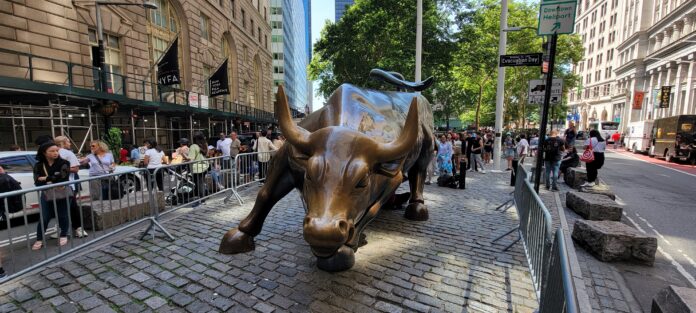The Charging Bull, often referred to as the Wall Street Bull, is one of the most iconic symbols of financial markets and Wall Street in New York City. Here are some interesting facts about this famous sculpture:
1. Creation and Installation
- Artist: The Charging Bull was created by Italian artist Arturo Di Modica. It was sculpted in bronze and weighs over 7,000 pounds (3,200 kg).
- Unsolicited Installation: The sculpture was installed without permission in front of the New York Stock Exchange (NYSE) in December 1989. Di Modica and a group of friends positioned the bull under a Christmas tree as a gift to New Yorkers.
2. Symbolism
- Financial Optimism: The Charging Bull symbolizes financial optimism and prosperity. It represents the aggressive financial optimism and prosperity of the American stock market.
- Bull Markets: In stock market terminology, a “bull market” refers to a period of rising stock prices, making the bull an apt symbol for the financial district.
3. Relocation
- Initial Removal: The NYSE initially removed the sculpture, but due to public demand, it was reinstalled a few blocks away at Bowling Green, where it has remained since December 1989.
- Current Location: The Bull is now located at Bowling Green Park, just north of the Staten Island Ferry Terminal. This site has become a popular tourist destination.
4. Tourist Attraction
- Popularity: The Charging Bull attracts thousands of tourists daily. It is one of the most photographed statues in New York City, with visitors often rubbing its nose, horns, and testicles for good luck.
- Cultural Icon: The statue has appeared in numerous movies, TV shows, and advertisements, further cementing its status as a cultural icon.
5. Artistic Features
- Dimensions: The sculpture is 11 feet (3.4 meters) tall and 16 feet (4.9 meters) long. Its imposing size and dynamic pose make it a striking presence.
- Dynamic Pose: The bull is depicted mid-charge, with its head down, nostrils flared, and muscles tensed, capturing a sense of power and movement.
6. Controversies and Protests
- Fearless Girl: In 2017, a bronze statue of a young girl, known as the Fearless Girl, was placed facing the bull to promote gender diversity and equality in the workplace. This addition sparked a debate about public art and its messages.
- Protests: The bull has been the site of various protests and demonstrations over the years, often related to economic inequality and Wall Street practices.
7. Artistic Intent
- Message of Resilience: Arturo Di Modica created the bull as a symbol of the strength and resilience of the American people, particularly following the 1987 stock market crash. He wanted the sculpture to inspire hope and confidence in the face of adversity.
8. Legal Ownership
- Ownership: Despite its public location, the Charging Bull is still privately owned by Di Modica. The artist has fought to maintain the integrity and location of his work, ensuring it remains a fixture of New York City.
9. Cultural References
- Global Influence: The Charging Bull has inspired similar sculptures in other financial districts around the world, including Shanghai, Amsterdam, and Frankfurt, highlighting its global impact on financial symbolism.
- Merchandise: The bull’s image has been widely used on merchandise, including souvenirs, clothing, and art prints, making it a recognizable emblem beyond Wall Street.
10. Artistic Process
- Creation: Di Modica spent around $360,000 of his own money to create the bull. The sculpture was cast in a foundry in Brooklyn and then transported to its initial location covertly.
- Labor of Love: The artist reportedly worked tirelessly for two years to complete the sculpture, driven by his passion and vision for the piece.
The Charging Bull remains a powerful symbol of Wall Street and the financial world. Its story, from an unsolicited gift to a beloved landmark, reflects the spirit of New York City and the resilience of its people.
